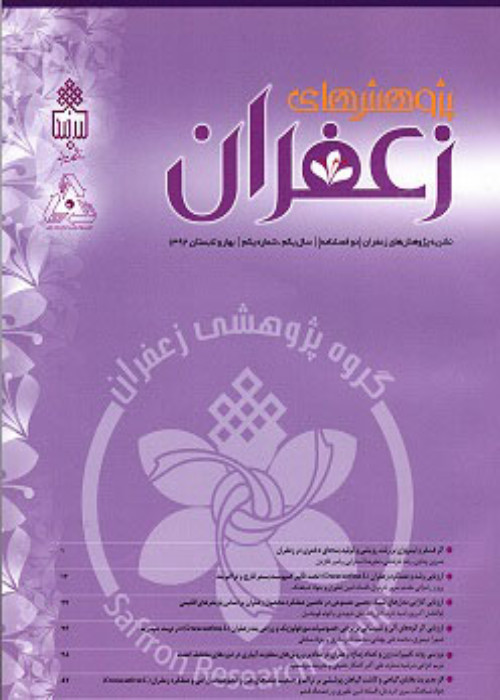Evaluation the Impact of Soil Texture and Climatic Parameters on Yield of Saffron (Crocus sativus L.) in Ghaen and Vamanan Regions
Author(s):
Article Type:
Research/Original Article (بدون رتبه معتبر)
Abstract:
Introduction
Iran is currently considered the largest producer of Saffron in the world and has the largest area under cultivation of this product. Saffron is cultivated in environments with very different soil characteristics. Saffron can be cultivated both in areas with low rainfall and in areas such as Greece with rainfall greater than 500 mm. Materials and Methods
Location of the Sampling Points: The present research was carried out during the time frame of 2015–2017 in two regions of Ghaen and Vamanan located in South Khorasan and Golestan Provinces, respectively. Sampling was done from 30 Saffron farms with three replications, i.e., 90 profiles were sampled from 3 to 5 years old farms in each of the studied areas in Ghaen and Vamanan to measure the soil texture. Saffron flowers were collected and the fresh weight was measured and then according to the area of the field, it was reported as kilograms per hectare. In order to explore the relation between the climatic parameters and the yield of Saffron in the regions under investigation, the climatic indicators of 5-year data (1390-1395) from the station of Vamanan and Ghaen were collected from the climatology center of Khorasan province and the climatic organization of Golestan province. Results and Discussion
Based on the results of the estimated regression model listed in table (4), clay, silt and the ratio of silt to sand of the investigated fields had a significant effect on the yield of Saffron in Ghaen at a significant level of less than 10%. In addition, the interaction effect of silt and sand (SCIN) on changes in Saffron yield was significant at the level of about 12%. Based on the estimation results, the effect of soil clay on the yield of Saffron was positive and significant. In such a way that by increasing this factor by one unit, it was expected that 0.19 kg would be added to the yield of Saffron. The effect of silt on changes in Saffron yield in Ghaen was positive and about 0.1 kg. As in Ghaen, quantitative relationship between Saffron yield and soil texture of investigated farms in Vamanan was also investigated using regression analysis. Another finding of the present research was the significance of the interaction between silt and clay. This effect was negative and indicated that these two factors reduced each other's effect on Saffron yield. Also, the model estimation results showed that the interaction effect of soil silt and sand was also significant and relatively significant in changes in Saffron yield. The small amount of this effect was about 0.012. Another result of estimating the regression model was the negative and significant effect of the ratio of soil silt and sand on Saffron yield. In such a way that by increasing the ratio of these two soil characteristics by one unit, Saffron yield was expected to decrease to a significant amount of 3.2 kg.hectare. Therefore, the balanced ratio of soil silt and sand will have a significant effect on the yield of Saffron. Some researchers believe that Saffron grows better in light soils rich in organic matter, while others stated that the best soil texture for planting Saffron is clay texture which is in contrary to the results of this research.The regression model showed that other conditions being constant, the yield of Saffron would be decreased by 0.125 kg per hectare with each increase in the number of frost days. The research results also indicated that if frost occurs during flowering, it will have a negative effect on the yield of the product. Also, rain during summer dormancy is harmful for Saffron. Conclusion
In the current research, the influence of the effective climatic indicators on the yield of Saffron in the two regions of Vamanan and Ghaen has been investigated. The results also showed that the yield per hectare of Saffron in Ghaen and Vamanan climates was affected by the number of frost days. On the other hand, the findings showed that the soil texture had an effect on all the growth characteristics of the Saffron plant, so that the use of soil with a lighter texture created optimal conditions for the growth of Saffron stem and ultimately increased the yield of Saffron flowers and stigmas.Keywords:
Language:
Persian
Published:
Journal of Saffron Research, Volume:10 Issue: 2, 2022
Pages:
195 to 214
magiran.com/p2554456
دانلود و مطالعه متن این مقاله با یکی از روشهای زیر امکان پذیر است:
اشتراک شخصی
با عضویت و پرداخت آنلاین حق اشتراک یکساله به مبلغ 1,390,000ريال میتوانید 70 عنوان مطلب دانلود کنید!
اشتراک سازمانی
به کتابخانه دانشگاه یا محل کار خود پیشنهاد کنید تا اشتراک سازمانی این پایگاه را برای دسترسی نامحدود همه کاربران به متن مطالب تهیه نمایند!
توجه!
- حق عضویت دریافتی صرف حمایت از نشریات عضو و نگهداری، تکمیل و توسعه مگیران میشود.
- پرداخت حق اشتراک و دانلود مقالات اجازه بازنشر آن در سایر رسانههای چاپی و دیجیتال را به کاربر نمیدهد.
In order to view content subscription is required
Personal subscription
Subscribe magiran.com for 70 € euros via PayPal and download 70 articles during a year.
Organization subscription
Please contact us to subscribe your university or library for unlimited access!




